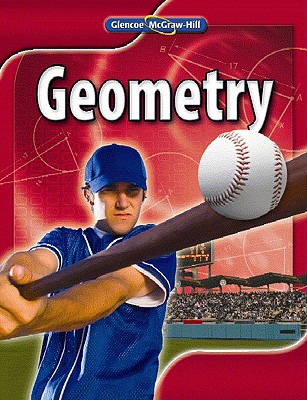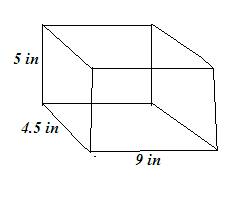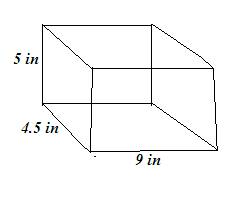
Geometry, Student Edition
1st Edition
ISBN: 9780078884849
Author: McGraw-Hill, McGraw Hill
Publisher: Glencoe/McGraw-Hill School Pub Co
expand_more
expand_more
format_list_bulleted
Question
Chapter 3.5, Problem 46STP
To determine
To find the approximate surface area of the figure.
Expert Solution & Answer
Answer to Problem 46STP
Option (D) is correct.
Explanation of Solution
Given information:
Figure

Formula used:
Surface area of the cuboid,
Where
l is length
w is width
h is height
Calculation:
Figure

Length of cuboid (in inch)
Width of cuboid (in inch)
Height of cuboid (in inch)
Using formula
On solving
On solving
On solving
Hence, option (D) is correct.
Chapter 3 Solutions
Geometry, Student Edition
Ch. 3.1 - Prob. 1ACYPCh. 3.1 - Prob. 1BCYPCh. 3.1 - Prob. 1CCYPCh. 3.1 - Prob. 2ACYPCh. 3.1 - Prob. 2BCYPCh. 3.1 - Prob. 2CCYPCh. 3.1 - Prob. 2DCYPCh. 3.1 - Prob. 3ACYPCh. 3.1 - Prob. 3BCYPCh. 3.1 - Prob. 3CCYP
Ch. 3.1 - Prob. 3DCYPCh. 3.1 - Prob. 1CYUCh. 3.1 - Prob. 2CYUCh. 3.1 - Prob. 3CYUCh. 3.1 - Prob. 4CYUCh. 3.1 - Prob. 5CYUCh. 3.1 - Prob. 6CYUCh. 3.1 - Prob. 7CYUCh. 3.1 - Prob. 8CYUCh. 3.1 - Prob. 9CYUCh. 3.1 - Prob. 10CYUCh. 3.1 - Prob. 11CYUCh. 3.1 - Prob. 12CYUCh. 3.1 - Prob. 13PPSCh. 3.1 - Prob. 14PPSCh. 3.1 - Prob. 15PPSCh. 3.1 - Prob. 16PPSCh. 3.1 - Prob. 17PPSCh. 3.1 - Prob. 18PPSCh. 3.1 - Prob. 19PPSCh. 3.1 - Prob. 20PPSCh. 3.1 - Prob. 21PPSCh. 3.1 - Prob. 22PPSCh. 3.1 - Prob. 23PPSCh. 3.1 - Prob. 24PPSCh. 3.1 - Prob. 25PPSCh. 3.1 - Prob. 26PPSCh. 3.1 - Prob. 27PPSCh. 3.1 - Prob. 28PPSCh. 3.1 - Prob. 29PPSCh. 3.1 - Prob. 30PPSCh. 3.1 - Prob. 31PPSCh. 3.1 - Prob. 32PPSCh. 3.1 - Prob. 33PPSCh. 3.1 - Prob. 34PPSCh. 3.1 - Prob. 35PPSCh. 3.1 - Prob. 36PPSCh. 3.1 - Prob. 37PPSCh. 3.1 - Prob. 38PPSCh. 3.1 - Prob. 39PPSCh. 3.1 - Prob. 40PPSCh. 3.1 - Prob. 41PPSCh. 3.1 - Prob. 42PPSCh. 3.1 - Prob. 43PPSCh. 3.1 - Prob. 44PPSCh. 3.1 - Prob. 45PPSCh. 3.1 - Prob. 46HPCh. 3.1 - Prob. 47HPCh. 3.1 - Prob. 48HPCh. 3.1 - Prob. 49HPCh. 3.1 - Prob. 50HPCh. 3.1 - Prob. 51STPCh. 3.1 - Prob. 52STPCh. 3.1 - Prob. 53STPCh. 3.1 - Prob. 54STPCh. 3.1 - Prob. 55SPRCh. 3.1 - Prob. 56SPRCh. 3.1 - Prob. 57SPRCh. 3.1 - Prob. 58SPRCh. 3.1 - Prob. 59SPRCh. 3.1 - Prob. 60SPRCh. 3.1 - Prob. 61SRCh. 3.1 - Prob. 62SRCh. 3.1 - Prob. 63SRCh. 3.2 - Prob. 1ACYPCh. 3.2 - Prob. 1BCYPCh. 3.2 - Prob. 1CCYPCh. 3.2 - Prob. 2ACYPCh. 3.2 - Prob. 2BCYPCh. 3.2 - Prob. 3ACYPCh. 3.2 - Prob. 3BCYPCh. 3.2 - Prob. 1CYUCh. 3.2 - Prob. 2CYUCh. 3.2 - Prob. 3CYUCh. 3.2 - Prob. 4CYUCh. 3.2 - Prob. 5CYUCh. 3.2 - Prob. 6CYUCh. 3.2 - Prob. 7CYUCh. 3.2 - Prob. 8CYUCh. 3.2 - Prob. 9CYUCh. 3.2 - Prob. 10CYUCh. 3.2 - Prob. 11PPSCh. 3.2 - Prob. 12PPSCh. 3.2 - Prob. 13PPSCh. 3.2 - Prob. 14PPSCh. 3.2 - Prob. 15PPSCh. 3.2 - Prob. 16PPSCh. 3.2 - Prob. 17PPSCh. 3.2 - Prob. 18PPSCh. 3.2 - Prob. 19PPSCh. 3.2 - Prob. 20PPSCh. 3.2 - Prob. 21PPSCh. 3.2 - Prob. 22PPSCh. 3.2 - Prob. 23PPSCh. 3.2 - Prob. 24PPSCh. 3.2 - Prob. 25PPSCh. 3.2 - Prob. 26PPSCh. 3.2 - Prob. 27PPSCh. 3.2 - Prob. 28PPSCh. 3.2 - Prob. 29PPSCh. 3.2 - Prob. 30PPSCh. 3.2 - Prob. 31PPSCh. 3.2 - Prob. 32PPSCh. 3.2 - Prob. 33PPSCh. 3.2 - Prob. 34PPSCh. 3.2 - Prob. 35PPSCh. 3.2 - Prob. 36PPSCh. 3.2 - Prob. 37PPSCh. 3.2 - Prob. 38PPSCh. 3.2 - Prob. 39PPSCh. 3.2 - Prob. 40PPSCh. 3.2 - Prob. 41PPSCh. 3.2 - Prob. 42HPCh. 3.2 - Prob. 43HPCh. 3.2 - Prob. 44HPCh. 3.2 - Prob. 45HPCh. 3.2 - Prob. 46HPCh. 3.2 - Prob. 47STPCh. 3.2 - Prob. 48STPCh. 3.2 - Prob. 49STPCh. 3.2 - Prob. 50STPCh. 3.2 - Prob. 51SPRCh. 3.2 - Prob. 52SPRCh. 3.2 - Prob. 53SPRCh. 3.2 - Prob. 54SPRCh. 3.2 - Prob. 55SPRCh. 3.2 - Prob. 56SRCh. 3.2 - Prob. 57SRCh. 3.2 - Prob. 58SRCh. 3.2 - Prob. 59SRCh. 3.2 - Prob. 60SRCh. 3.2 - Prob. 61SRCh. 3.3 - Prob. 1ACYPCh. 3.3 - Prob. 1BCYPCh. 3.3 - Prob. 1CCYPCh. 3.3 - Prob. 1DCYPCh. 3.3 - Prob. 2CYPCh. 3.3 - Prob. 3ACYPCh. 3.3 - Prob. 3BCYPCh. 3.3 - Prob. 4CYPCh. 3.3 - Prob. 1CYUCh. 3.3 - Prob. 2CYUCh. 3.3 - Prob. 3CYUCh. 3.3 - Prob. 4CYUCh. 3.3 - Prob. 5CYUCh. 3.3 - Prob. 6CYUCh. 3.3 - Prob. 7CYUCh. 3.3 - Prob. 8CYUCh. 3.3 - Prob. 9CYUCh. 3.3 - Prob. 10CYUCh. 3.3 - Prob. 11CYUCh. 3.3 - Prob. 12PPSCh. 3.3 - Prob. 13PPSCh. 3.3 - Prob. 14PPSCh. 3.3 - Prob. 15PPSCh. 3.3 - Prob. 16PPSCh. 3.3 - Prob. 17PPSCh. 3.3 - Prob. 18PPSCh. 3.3 - Prob. 19PPSCh. 3.3 - Prob. 20PPSCh. 3.3 - Prob. 21PPSCh. 3.3 - Prob. 22PPSCh. 3.3 - Prob. 23PPSCh. 3.3 - Prob. 24PPSCh. 3.3 - Prob. 25PPSCh. 3.3 - Prob. 26PPSCh. 3.3 - Prob. 27PPSCh. 3.3 - Prob. 28PPSCh. 3.3 - Prob. 29PPSCh. 3.3 - Prob. 30PPSCh. 3.3 - Prob. 31PPSCh. 3.3 - Prob. 32PPSCh. 3.3 - Prob. 33PPSCh. 3.3 - Prob. 34PPSCh. 3.3 - Prob. 35PPSCh. 3.3 - Prob. 36PPSCh. 3.3 - Prob. 37PPSCh. 3.3 - Prob. 38PPSCh. 3.3 - Prob. 39PPSCh. 3.3 - Prob. 40PPSCh. 3.3 - Prob. 41PPSCh. 3.3 - Prob. 42PPSCh. 3.3 - Prob. 43PPSCh. 3.3 - Prob. 44PPSCh. 3.3 - Prob. 45PPSCh. 3.3 - Prob. 46PPSCh. 3.3 - Prob. 47PPSCh. 3.3 - Prob. 48PPSCh. 3.3 - Prob. 49PPSCh. 3.3 - Prob. 50PPSCh. 3.3 - Prob. 51PPSCh. 3.3 - Prob. 52HPCh. 3.3 - Prob. 53HPCh. 3.3 - Prob. 54HPCh. 3.3 - Prob. 55HPCh. 3.3 - Prob. 56HPCh. 3.3 - Prob. 57HPCh. 3.3 - Prob. 58STPCh. 3.3 - Prob. 59STPCh. 3.3 - Prob. 60STPCh. 3.3 - Prob. 61STPCh. 3.3 - Prob. 62SPRCh. 3.3 - Prob. 63SPRCh. 3.3 - Prob. 64SPRCh. 3.3 - Prob. 65SPRCh. 3.3 - Prob. 66SPRCh. 3.3 - Prob. 67SPRCh. 3.3 - Prob. 68SPRCh. 3.3 - Prob. 69SPRCh. 3.3 - Prob. 70SPRCh. 3.3 - Prob. 71SPRCh. 3.3 - Prob. 72SRCh. 3.3 - Prob. 73SRCh. 3.3 - Prob. 74SRCh. 3.4 - Prob. 1CYPCh. 3.4 - Prob. 2CYPCh. 3.4 - Prob. 3ACYPCh. 3.4 - Prob. 3BCYPCh. 3.4 - Prob. 4CYPCh. 3.4 - Prob. 5CYPCh. 3.4 - Prob. 6CYPCh. 3.4 - Prob. 1CYUCh. 3.4 - Prob. 2CYUCh. 3.4 - Prob. 3CYUCh. 3.4 - Prob. 4CYUCh. 3.4 - Prob. 5CYUCh. 3.4 - Prob. 6CYUCh. 3.4 - Prob. 7CYUCh. 3.4 - Prob. 8CYUCh. 3.4 - Prob. 9CYUCh. 3.4 - Prob. 10CYUCh. 3.4 - Prob. 11CYUCh. 3.4 - Prob. 12CYUCh. 3.4 - Prob. 13PPSCh. 3.4 - Prob. 14PPSCh. 3.4 - Prob. 15PPSCh. 3.4 - Prob. 16PPSCh. 3.4 - Prob. 17PPSCh. 3.4 - Prob. 18PPSCh. 3.4 - Prob. 19PPSCh. 3.4 - Prob. 20PPSCh. 3.4 - Prob. 21PPSCh. 3.4 - Prob. 22PPSCh. 3.4 - Prob. 23PPSCh. 3.4 - Prob. 24PPSCh. 3.4 - Prob. 25PPSCh. 3.4 - Prob. 26PPSCh. 3.4 - Prob. 27PPSCh. 3.4 - Prob. 28PPSCh. 3.4 - Prob. 29PPSCh. 3.4 - Prob. 30PPSCh. 3.4 - Prob. 31PPSCh. 3.4 - Prob. 32PPSCh. 3.4 - Prob. 33PPSCh. 3.4 - Prob. 34PPSCh. 3.4 - Prob. 35PPSCh. 3.4 - Prob. 36PPSCh. 3.4 - Prob. 37PPSCh. 3.4 - Prob. 38PPSCh. 3.4 - Prob. 39PPSCh. 3.4 - Prob. 40PPSCh. 3.4 - Prob. 41PPSCh. 3.4 - Prob. 42PPSCh. 3.4 - Prob. 43PPSCh. 3.4 - Prob. 44PPSCh. 3.4 - Prob. 45PPSCh. 3.4 - Prob. 46PPSCh. 3.4 - Prob. 47PPSCh. 3.4 - Prob. 48PPSCh. 3.4 - Prob. 49PPSCh. 3.4 - Prob. 50PPSCh. 3.4 - Prob. 51PPSCh. 3.4 - Prob. 52PPSCh. 3.4 - Prob. 53PPSCh. 3.4 - Prob. 54PPSCh. 3.4 - Prob. 55HPCh. 3.4 - Prob. 56HPCh. 3.4 - Prob. 57HPCh. 3.4 - Prob. 58HPCh. 3.4 - Prob. 59HPCh. 3.4 - Prob. 60STPCh. 3.4 - Prob. 61STPCh. 3.4 - Prob. 62STPCh. 3.4 - Prob. 63STPCh. 3.4 - Prob. 64SPRCh. 3.4 - Prob. 65SPRCh. 3.4 - Prob. 66SPRCh. 3.4 - Prob. 67SPRCh. 3.4 - Prob. 68SPRCh. 3.4 - Prob. 69SPRCh. 3.4 - Prob. 70SRCh. 3.4 - Prob. 71SRCh. 3.4 - Prob. 72SRCh. 3.4 - Prob. 73SRCh. 3.5 - Prob. 1ACYPCh. 3.5 - Prob. 1BCYPCh. 3.5 - Prob. 1CCYPCh. 3.5 - Prob. 1DCYPCh. 3.5 - Prob. 1ECYPCh. 3.5 - Prob. 1FCYPCh. 3.5 - Prob. 2CYPCh. 3.5 - Prob. 3CYPCh. 3.5 - Prob. 1CYUCh. 3.5 - Prob. 2CYUCh. 3.5 - Prob. 3CYUCh. 3.5 - Prob. 4CYUCh. 3.5 - Prob. 5CYUCh. 3.5 - Prob. 6CYUCh. 3.5 - Prob. 7CYUCh. 3.5 - Prob. 8PPSCh. 3.5 - Prob. 9PPSCh. 3.5 - Prob. 10PPSCh. 3.5 - Prob. 11PPSCh. 3.5 - Prob. 12PPSCh. 3.5 - Prob. 13PPSCh. 3.5 - Prob. 14PPSCh. 3.5 - Prob. 15PPSCh. 3.5 - Prob. 16PPSCh. 3.5 - Prob. 17PPSCh. 3.5 - Prob. 18PPSCh. 3.5 - Prob. 19PPSCh. 3.5 - Prob. 20PPSCh. 3.5 - Prob. 21PPSCh. 3.5 - Prob. 22PPSCh. 3.5 - Prob. 23PPSCh. 3.5 - Prob. 24PPSCh. 3.5 - Prob. 25PPSCh. 3.5 - Prob. 26PPSCh. 3.5 - Prob. 27PPSCh. 3.5 - Prob. 28PPSCh. 3.5 - Prob. 29PPSCh. 3.5 - Prob. 30PPSCh. 3.5 - Prob. 31PPSCh. 3.5 - Prob. 32PPSCh. 3.5 - Prob. 33PPSCh. 3.5 - Prob. 34PPSCh. 3.5 - Prob. 35PPSCh. 3.5 - Prob. 36PPSCh. 3.5 - Prob. 37HPCh. 3.5 - Prob. 38HPCh. 3.5 - Prob. 39HPCh. 3.5 - Prob. 40HPCh. 3.5 - Prob. 41HPCh. 3.5 - Prob. 42HPCh. 3.5 - Prob. 43HPCh. 3.5 - Prob. 44STPCh. 3.5 - Prob. 45STPCh. 3.5 - Prob. 46STPCh. 3.5 - Prob. 47STPCh. 3.5 - Prob. 48SPRCh. 3.5 - Prob. 49SPRCh. 3.5 - Prob. 50SPRCh. 3.5 - Prob. 51SPRCh. 3.5 - Prob. 52SPRCh. 3.5 - Prob. 53SPRCh. 3.5 - Prob. 54SPRCh. 3.5 - Prob. 55SPRCh. 3.5 - Prob. 56SPRCh. 3.5 - Prob. 57SRCh. 3.6 - Prob. 1CYPCh. 3.6 - Prob. 2CYPCh. 3.6 - Prob. 3ACYPCh. 3.6 - Prob. 3BCYPCh. 3.6 - Prob. 1CYUCh. 3.6 - Prob. 2CYUCh. 3.6 - Prob. 3CYUCh. 3.6 - Prob. 4CYUCh. 3.6 - Prob. 5CYUCh. 3.6 - Prob. 6CYUCh. 3.6 - Prob. 7CYUCh. 3.6 - Prob. 8CYUCh. 3.6 - Prob. 9PPSCh. 3.6 - Prob. 10PPSCh. 3.6 - Prob. 11PPSCh. 3.6 - Prob. 12PPSCh. 3.6 - Prob. 13PPSCh. 3.6 - Prob. 14PPSCh. 3.6 - Prob. 15PPSCh. 3.6 - Prob. 16PPSCh. 3.6 - Prob. 17PPSCh. 3.6 - Prob. 18PPSCh. 3.6 - Prob. 19PPSCh. 3.6 - Prob. 20PPSCh. 3.6 - Prob. 21PPSCh. 3.6 - Prob. 22PPSCh. 3.6 - Prob. 23PPSCh. 3.6 - Prob. 24PPSCh. 3.6 - Prob. 25PPSCh. 3.6 - Prob. 26PPSCh. 3.6 - Prob. 27PPSCh. 3.6 - Prob. 28PPSCh. 3.6 - Prob. 29PPSCh. 3.6 - Prob. 30PPSCh. 3.6 - Prob. 31PPSCh. 3.6 - Prob. 32PPSCh. 3.6 - Prob. 33PPSCh. 3.6 - Prob. 34PPSCh. 3.6 - Prob. 35PPSCh. 3.6 - Prob. 36PPSCh. 3.6 - Prob. 37PPSCh. 3.6 - Prob. 38PPSCh. 3.6 - Prob. 39PPSCh. 3.6 - Prob. 40PPSCh. 3.6 - Prob. 41HPCh. 3.6 - Prob. 42HPCh. 3.6 - Prob. 43HPCh. 3.6 - Prob. 44HPCh. 3.6 - Prob. 45HPCh. 3.6 - Prob. 46HPCh. 3.6 - Prob. 47HPCh. 3.6 - Prob. 48STPCh. 3.6 - Prob. 49STPCh. 3.6 - Prob. 50STPCh. 3.6 - Prob. 51STPCh. 3.6 - Prob. 52SPRCh. 3.6 - Prob. 53SPRCh. 3.6 - Prob. 54SPRCh. 3.6 - Prob. 55SPRCh. 3.6 - Prob. 56SPRCh. 3.6 - Prob. 57SPRCh. 3.6 - Prob. 58SPRCh. 3.6 - Prob. 59SPRCh. 3.6 - Prob. 60SRCh. 3.6 - Prob. 61SRCh. 3.6 - Prob. 62SRCh. 3.6 - Prob. 63SRCh. 3.6 - Prob. 64SRCh. 3.6 - Prob. 65SRCh. 3 - Prob. 1GRFCCh. 3 - Prob. 2GRFCCh. 3 - Prob. 3GRFCCh. 3 - Prob. 4GRFCCh. 3 - Prob. 5GRFCCh. 3 - Prob. 6GRFCCh. 3 - Prob. 7GRFCCh. 3 - Prob. 8GRFCCh. 3 - Prob. 9GRFCCh. 3 - Prob. 10GRFCCh. 3 - Prob. 11GRFCCh. 3 - Prob. 12GRFCCh. 3 - Prob. 1MCQCh. 3 - Prob. 2MCQCh. 3 - Prob. 3MCQCh. 3 - Prob. 4MCQCh. 3 - Prob. 5MCQCh. 3 - Prob. 6MCQCh. 3 - Prob. 7MCQCh. 3 - Prob. 8MCQCh. 3 - Prob. 9MCQCh. 3 - Prob. 10MCQCh. 3 - Prob. 11MCQCh. 3 - Prob. 12MCQCh. 3 - Prob. 13MCQCh. 3 - Prob. 14MCQCh. 3 - Prob. 15MCQCh. 3 - Prob. 16MCQCh. 3 - Prob. 17MCQCh. 3 - Prob. 18MCQCh. 3 - Prob. 19MCQCh. 3 - Prob. 20MCQCh. 3 - Prob. 1SGRCh. 3 - Prob. 2SGRCh. 3 - Prob. 3SGRCh. 3 - Prob. 4SGRCh. 3 - Prob. 5SGRCh. 3 - Prob. 6SGRCh. 3 - Prob. 7SGRCh. 3 - Prob. 8SGRCh. 3 - Prob. 9SGRCh. 3 - Prob. 10SGRCh. 3 - Prob. 11SGRCh. 3 - Prob. 12SGRCh. 3 - Prob. 13SGRCh. 3 - Prob. 14SGRCh. 3 - Prob. 15SGRCh. 3 - Prob. 16SGRCh. 3 - Prob. 17SGRCh. 3 - Prob. 18SGRCh. 3 - Prob. 19SGRCh. 3 - Prob. 20SGRCh. 3 - Prob. 21SGRCh. 3 - Prob. 22SGRCh. 3 - Prob. 23SGRCh. 3 - Prob. 24SGRCh. 3 - Prob. 25SGRCh. 3 - Prob. 26SGRCh. 3 - Prob. 27SGRCh. 3 - Prob. 28SGRCh. 3 - Prob. 29SGRCh. 3 - Prob. 30SGRCh. 3 - Prob. 31SGRCh. 3 - Prob. 32SGRCh. 3 - Prob. 33SGRCh. 3 - Prob. 34SGRCh. 3 - Prob. 35SGRCh. 3 - Prob. 36SGRCh. 3 - Prob. 37SGRCh. 3 - Prob. 38SGRCh. 3 - Prob. 39SGRCh. 3 - Prob. 40SGRCh. 3 - Prob. 41SGRCh. 3 - Prob. 42SGRCh. 3 - Prob. 1PTCh. 3 - Prob. 2PTCh. 3 - Prob. 3PTCh. 3 - Prob. 4PTCh. 3 - Prob. 5PTCh. 3 - Prob. 6PTCh. 3 - Prob. 7PTCh. 3 - Prob. 8PTCh. 3 - Prob. 9PTCh. 3 - Prob. 10PTCh. 3 - Prob. 11PTCh. 3 - Prob. 12PTCh. 3 - Prob. 13PTCh. 3 - Prob. 14PTCh. 3 - Prob. 15PTCh. 3 - Prob. 16PTCh. 3 - Prob. 17PTCh. 3 - Prob. 18PTCh. 3 - Prob. 19PTCh. 3 - Prob. 20PTCh. 3 - Prob. 21PTCh. 3 - Prob. 22PTCh. 3 - Prob. 23PTCh. 3 - Prob. 24PTCh. 3 - Prob. 25PTCh. 3 - Prob. 1STPCh. 3 - Prob. 2STPCh. 3 - Prob. 3STPCh. 3 - Prob. 4STPCh. 3 - Prob. 5STPCh. 3 - Prob. 6STPCh. 3 - Prob. 7STPCh. 3 - Prob. 8STPCh. 3 - Prob. 9STPCh. 3 - Prob. 10STPCh. 3 - Prob. 11STPCh. 3 - Prob. 12STPCh. 3 - Prob. 13STP
Additional Math Textbook Solutions
Find more solutions based on key concepts
Chain Rule using a table Let h(x)= f(g(x)) and p(x) = g(f(x)). Use the table to compute the following derivativ...
Calculus: Early Transcendentals (2nd Edition)
Expression for total number of beads.
Pre-Algebra Student Edition
The following set of data is from sample of n=5: a. Compute the mean, median, and mode. b. Compute the range, v...
Basic Business Statistics, Student Value Edition
Testing Hypotheses. In Exercises 13-24, assume that a simple random sample has been selected and test the given...
Elementary Statistics (13th Edition)
1. combination of numbers, variables, and operation symbols is called an algebraic______.
Algebra and Trigonometry (6th Edition)
Knowledge Booster
Learn more about
Need a deep-dive on the concept behind this application? Look no further. Learn more about this topic, geometry and related others by exploring similar questions and additional content below.Similar questions
- 39 Two sides of one triangle are congruent to two sides of a second triangle, and the included angles are supplementary. The area of one triangle is 41. Can the area of the second triangle be found?arrow_forwardA parallelogram with an area of 211.41 m^2 hast a base Thatcher measures 24.3m. Find ist height.arrow_forwardBH is tangent to circle A and DF is a diameter. I don't know where to go from here. May you help please?arrow_forward
arrow_back_ios
SEE MORE QUESTIONS
arrow_forward_ios
Recommended textbooks for you
 Elementary Geometry For College Students, 7eGeometryISBN:9781337614085Author:Alexander, Daniel C.; Koeberlein, Geralyn M.Publisher:Cengage,
Elementary Geometry For College Students, 7eGeometryISBN:9781337614085Author:Alexander, Daniel C.; Koeberlein, Geralyn M.Publisher:Cengage, Elementary Geometry for College StudentsGeometryISBN:9781285195698Author:Daniel C. Alexander, Geralyn M. KoeberleinPublisher:Cengage Learning
Elementary Geometry for College StudentsGeometryISBN:9781285195698Author:Daniel C. Alexander, Geralyn M. KoeberleinPublisher:Cengage Learning

Elementary Geometry For College Students, 7e
Geometry
ISBN:9781337614085
Author:Alexander, Daniel C.; Koeberlein, Geralyn M.
Publisher:Cengage,

Elementary Geometry for College Students
Geometry
ISBN:9781285195698
Author:Daniel C. Alexander, Geralyn M. Koeberlein
Publisher:Cengage Learning
What is a Prism? | Types of Prism | Don't Memorise; Author: Don't Memorise;https://www.youtube.com/watch?v=wxDTrgnyu28;License: Standard YouTube License, CC-BY